Trovare la maschera da sci giusta per la forma e le dimensioni del viso è fondamentale sia per lo stile che per il comfort sulle piste. Le maschere da sci non solo proteggono gli occhi dagli agenti atmosferici, ma migliorano anche l'esperienza sciistica complessiva, migliorando la visibilità e riducendo i riflessi. In questa guida completa, esploreremo le diverse forme e dimensioni del viso e forniremo consigli di esperti per scegliere la maschera da sci perfetta per ciascuna di esse.
Capire le forme e le dimensioni del viso
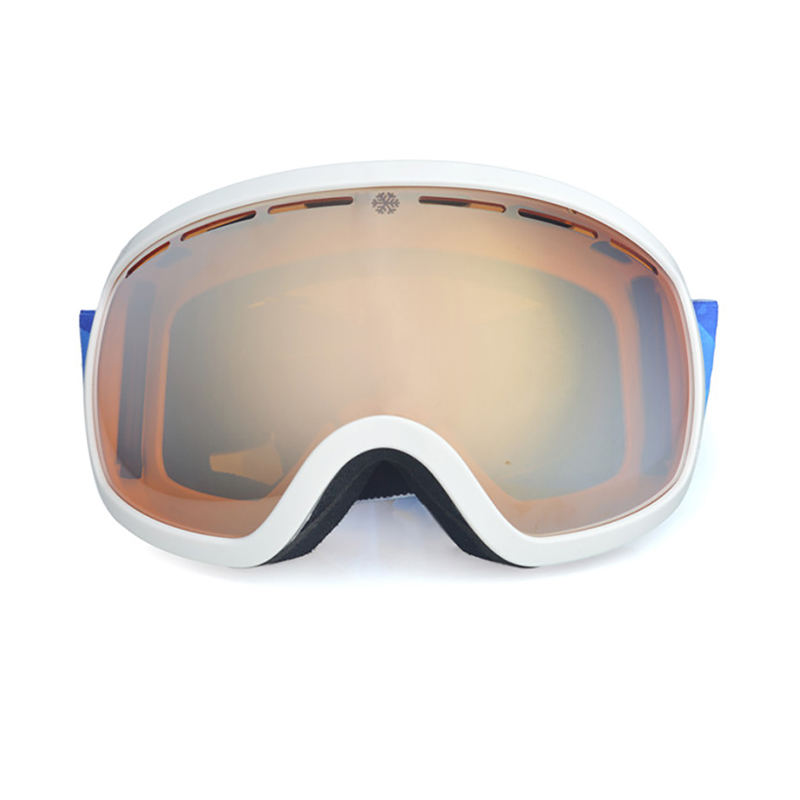
Forma del viso ovale:
Una forma del viso ovale è caratterizzata da proporzioni equilibrate e contorni dolcemente arrotondati.
Gli occhiali da sci con montatura da media a grande sono ideali per i visi ovali poiché completano la naturale simmetria del viso. Stili con un design leggermente avvolgente può valorizzare ulteriormente la forma ovale del viso.
Quando si sceglie una maschera da sci per un viso ovale, è fondamentale garantire una calzata confortevole, considerando la larghezza e l'altezza della maschera. Optate per una maschera che copra adeguatamente gli occhi senza creare punti di pressione sulle tempie o sul ponte nasale.
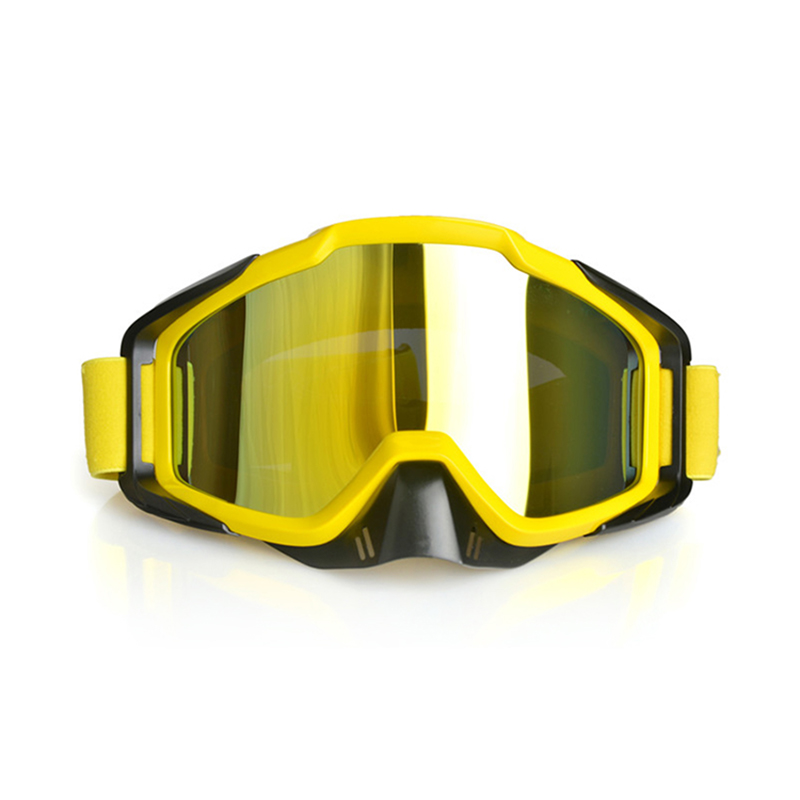
Forma del viso rotonda:
Un viso dalla forma rotonda presenta guance più piene e un mento arrotondato.
Gli occhiali da sci con montature angolari, rettangolari o oversize sono ottime scelte Per chi ha il viso rotondo, perché aggiunge struttura visiva e lunghezza al viso. Optate per stili con zigomi alti per attirare l'attenzione verso l'alto.
Per i visi rotondi, le dimensioni consigliate includono la scelta di occhiali con una montatura ampia per creare equilibrio ed evitare una sensazione di costrizione.
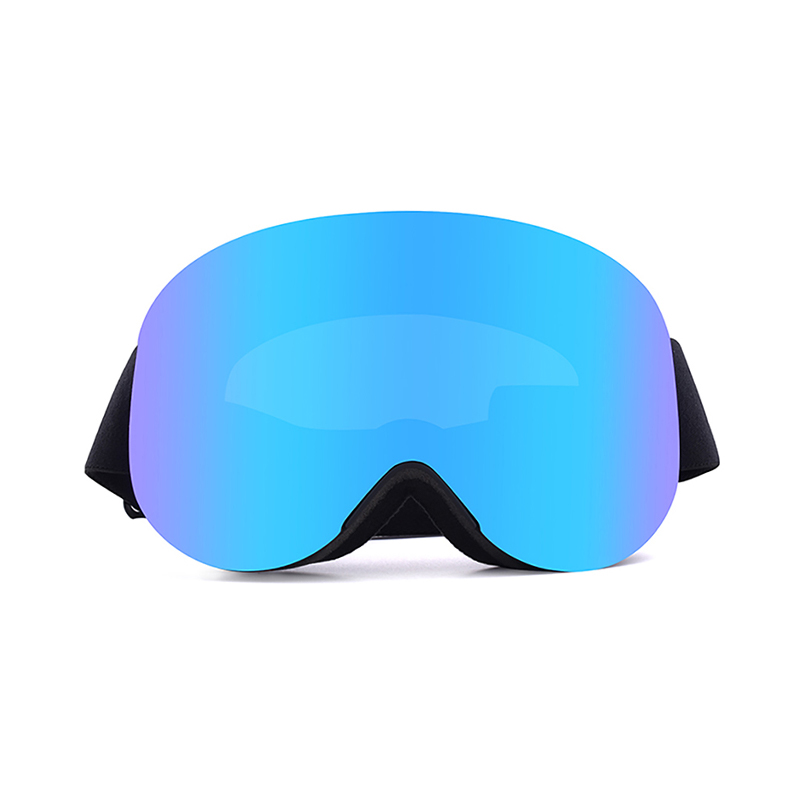
Forma del viso quadrata:
Una forma del viso quadrata è caratterizzata da un mascella pronunciata e fronte e zigomi proporzionati in modo uniforme.
Gli occhiali da sci con montatura arrotondata o ovale possono aiutare ad ammorbidire gli angoli di un viso squadrato. Stili con aste e montature più sottili può aggiungere equilibrio e creare un aspetto più armonioso.
Quando si scelgono degli occhiali da sci per un viso quadrato, è essenziale trovare la larghezza e la copertura giuste per mantenere le proporzioni ed evitare spazi tra gli occhiali e il viso.
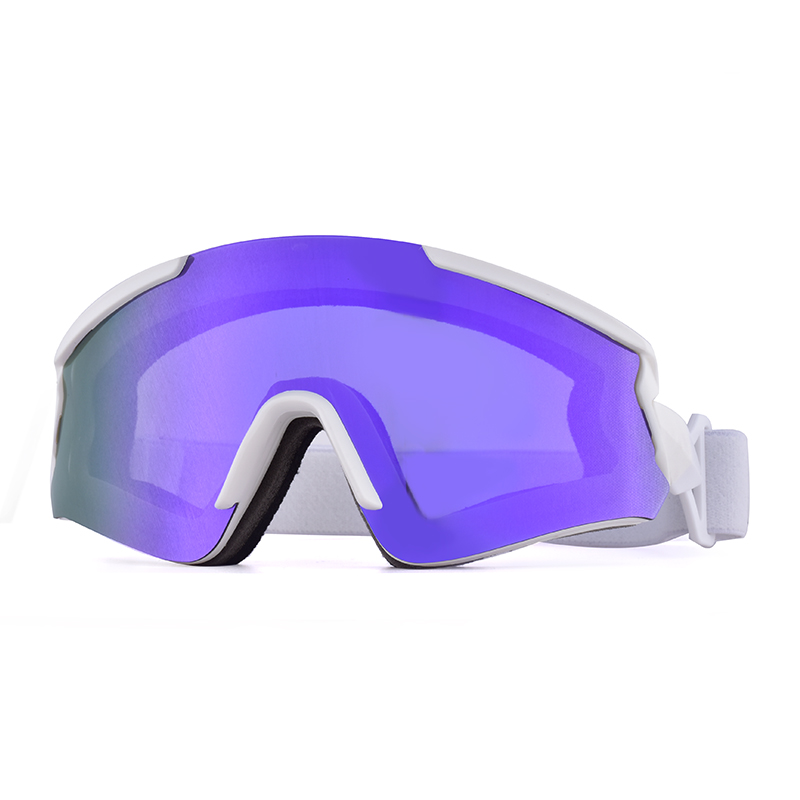
Forma del viso a cuore:
Un viso a forma di cuore presenta una fronte più ampia e una mascella più stretta.
Gli occhiali da sci con design a occhi di gatto o ispirati agli aviatori possono valorizzare un viso a forma di cuore portando l'attenzione verso il basso e bilanciando le proporzioni del viso. Opta per occhiali con un telaio superiore più largo e telaio inferiore più stretto per valorizzare la forma del viso.
Regolare i cinturini degli occhiali da sci per garantire una vestibilità aderente, senza creare fastidio o pressione sulle tempie o sul ponte nasale.
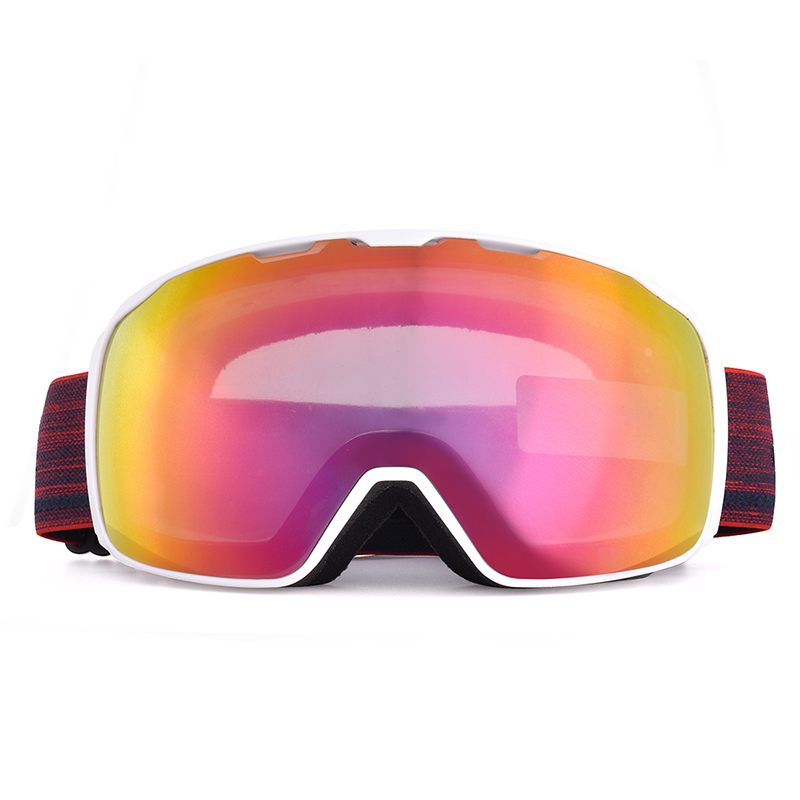
Forma del viso oblunga:
Una forma del viso oblunga è caratterizzata da proporzioni lunghe e strette con mascella dritta.
Occhiali da sci con montatura ampia e accento orizzontale Può aiutare a valorizzare la forma oblunga del viso. Cercate modelli avvolgenti o oversize che aggiungano larghezza al viso.
Prendi in considerazione suggerimenti sulle dimensioni, ad esempio scegliendo occhiali che coprano completamente gli occhi senza premere eccessivamente sul ponte nasale, per evitare fastidi e punti di pressione.

Forma del viso a diamante:
Un viso a forma di diamante presenta zigomi alti, fronte stretta e mento affusolato.
Gli occhiali da sci con montatura ovale o a occhio di gatto possono aiutare a bilanciare gli angoli di un viso a forma di diamanteCerca stili più larghi nella parte superiore e più stretti in quella inferiore per armonizzare la forma del viso.
Si consiglia di scegliere occhiali da sci con lenti della giusta forma e dimensione per garantire una copertura adeguata ed evitare distorsioni della visione periferica.
Scegliere gli occhiali da sci in base alle dimensioni del viso
Dimensioni del viso piccole:
Un viso piccolo è caratterizzato da lineamenti delicati e da una larghezza complessiva più stretta.
Le maschere da sci con montatura compatta e lenti più piccole sono adatte ai visi piccoli. Cercate maschere con una vestibilità a basso profilo e aste sottili per evitare che la maschera sovrastino il viso.
Regolare i cinturini degli occhiali per una vestibilità comoda e sicura, senza creare punti di pressione o spazi vuoti.
Dimensioni del viso medie:
Un viso di medie dimensioni presenta proporzioni equilibrate e una larghezza moderata.
Le maschere da sci con montatura versatile e lenti di medie dimensioni sono adatte a visi di medie dimensioni. Cerca modelli che offrano un buon equilibrio tra copertura e stile.
Una ventilazione adeguata è fondamentale per i visi di medie dimensioni per prevenire l'appannamento. Cercate occhiali con aperture di ventilazione posizionate strategicamente e sistemi di ventilazione regolabili per un'esperienza confortevole e senza appannamento.
Viso grande:
Un viso grande è caratterizzato da lineamenti più ampi e da una larghezza complessiva maggiore.
Le maschere da sci con montatura più grande e lenti ampie offrono una copertura adeguata per i visi più grandi. Optate per modelli con una vestibilità leggermente oversize per un look elegante e proporzionato.
Assicuratevi che gli occhiali da sci offrano una buona visione periferica e un ampio campo visivo per garantire sicurezza e attenzione sulle piste.
Fattori da considerare nella scelta degli occhiali da sci

Tecnologia e tinte delle lenti:
Diverse tecnologie delle lenti, come le lenti polarizzate o fotocromatiche, offrono vantaggi specifici, come la riduzione dell'abbagliamento o l'adattamento alle mutevoli condizioni di luce.
Scegli la tonalità di lente più adatta alle diverse condizioni meteorologiche e livelli di luce. Le tonalità a specchio o scure sono ideali per le giornate di sole splendente, mentre le tonalità più chiare o le lenti trasparenti sono perfette per lo sci in condizioni di scarsa illuminazione o di notte.
Cercate occhiali da sci con rivestimenti antiappannamento e antigraffio per garantire una lunga durata e una visibilità nitida.
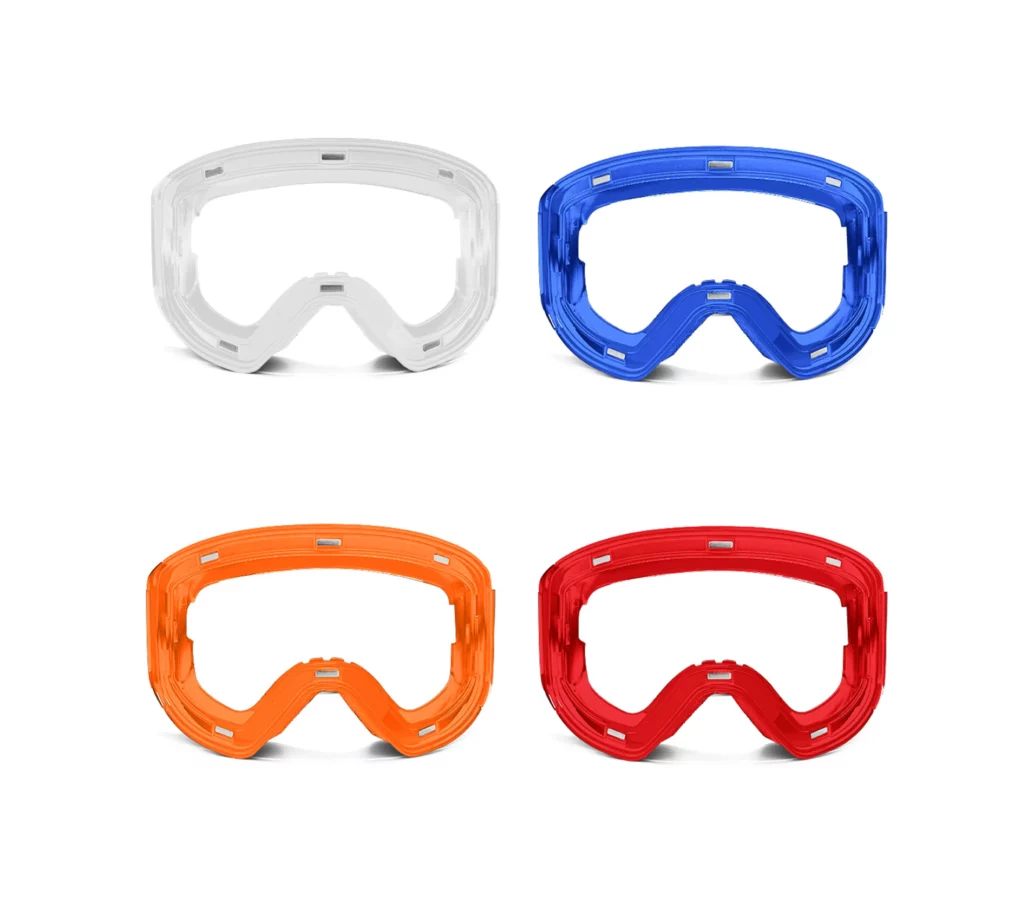
Costruzione e materiali del telaio:
Gli occhiali da sci sono disponibili con montature di materiali diversi, tra cui plastica, poliuretano termoplastico (TPU) o fibra di carbonio, ognuno dei quali offre vantaggi in termini di peso, flessibilità e resistenza agli urti.
Scegli materiali leggeri e flessibili per la montatura per un comfort ottimale durante le lunghe ore sulle piste. Cerca montature con imbottitura in schiuma per una maggiore ammortizzazione e una calzata aderente.
Considerate la resistenza agli urti e la durata nella scelta della montatura. Gli occhiali con una montatura robusta e cerniere rinforzate resisteranno alle sollecitazioni dello sci e proteggeranno da potenziali incidenti.
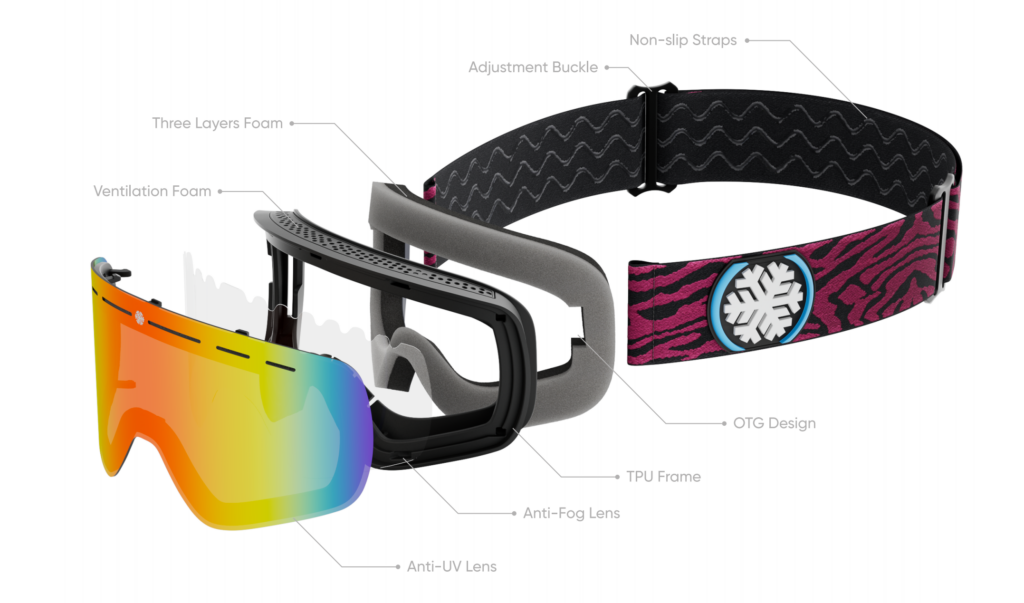
Ventilazione e flusso d'aria:
Una ventilazione adeguata è essenziale per prevenire l'appannamento causato dall'umidità intrappolata. Cercate maschere da sci dotate di sistemi di ventilazione efficaci, come prese d'aria o canali posizionati strategicamente, per favorire il flusso d'aria e ridurre al minimo l'appannamento.
Gli occhiali da sci con opzioni di ventilazione regolabili consentono un controllo personalizzato del flusso d'aria, consentendo agli sciatori di adattarsi alle diverse condizioni atmosferiche e ai diversi livelli di sforzo.
Regola le prese d'aria e le cinghie per un controllo personalizzato del flusso d'aria e una vestibilità comoda che supporta un flusso d'aria ottimale mantenendo la stabilità.
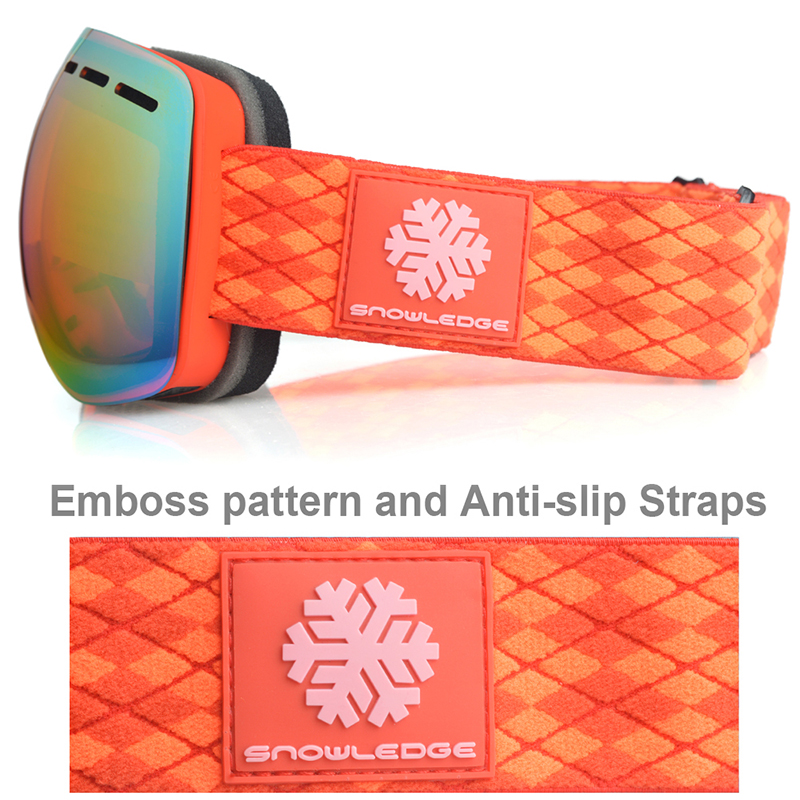
Design e compatibilità del cinturino:
I cinturini larghi sono essenziali per la stabilità e garantiscono una vestibilità sicura. Cerca occhiali con cinturini regolabili che possono essere stretti o allentati a seconda delle necessità, per il massimo comfort e stabilità.
Considerare la lunghezza del cinturino e la compatibilità con diverse taglie di casco per garantire una corretta aderenza tra gli occhiali e il sistema del casco. Il cinturino deve essere sufficientemente lungo da fissare saldamente gli occhiali al viso, adattandosi a diverse taglie di testa.
Verificare la compatibilità tra i modelli e le marche di occhiali da sci e caschi per garantire un'integrazione perfetta ed evitare qualsiasi disagio o spazio vuoto.
Ulteriori suggerimenti per la scelta degli occhiali da sci
Prova e test degli occhiali da sci:
Provare gli occhiali da sci prima di acquistarli è fondamentale, poiché ciò consente di valutare correttamente la vestibilità, il comfort e il campo visivo.
Controllare che la pressione sia distribuita uniformemente e che non vi siano spazi vuoti tra gli occhiali e il viso. Gli occhiali devono essere aderenti per offrire una protezione ottimale e impedire l'ingresso di aria fredda o neve.
Testare il campo visivo e la visione periferica degli occhiali Muovendo la testa e gli occhi in diverse direzioni. Assicuratevi che non vi siano ostacoli o distorsioni che possano compromettere la sicurezza sulle piste.
Prendersi cura dei propri occhiali da sci:
Tecniche di pulizia e manutenzione adeguate sono essenziali per prolungare la durata degli occhiali da sci. Utilizzare un panno morbido in microfibra e un detergente per lenti per rimuovere sporco e detriti senza graffiare le lenti.
Conservare gli occhiali da sci in custodie protettive per evitare danni e graffi quando non vengono utilizzati. Evitare di lasciarli esposti a temperature estreme o alla luce solare diretta.
Ispezionare e sostituire regolarmente le parti usurate o danneggiate, come l'imbottitura in schiuma o i cinturini, per mantenere un comfort e una sicurezza ottimali durante lo sci.
Promemoria: non dimenticare di considerare tra occhiali da vista e occhiali da vista OTG se hai bisogno di indossare gli occhiali mentre scii.
Conclusione
Trovare una maschera da sci adatta alla forma e alle dimensioni del tuo viso è fondamentale sia per lo stile che per le prestazioni sulle piste. Conoscendo le caratteristiche delle diverse forme del viso, valutando attentamente le taglie e tenendo conto di fattori come la tecnologia delle lenti, la struttura della montatura, la ventilazione e il design del cinturino, puoi scegliere la maschera da sci perfetta che offra comfort, protezione e stile ottimali. Affronta le piste con sicurezza, sapendo di aver scelto una maschera da sci che migliora la tua esperienza sciistica complessiva.

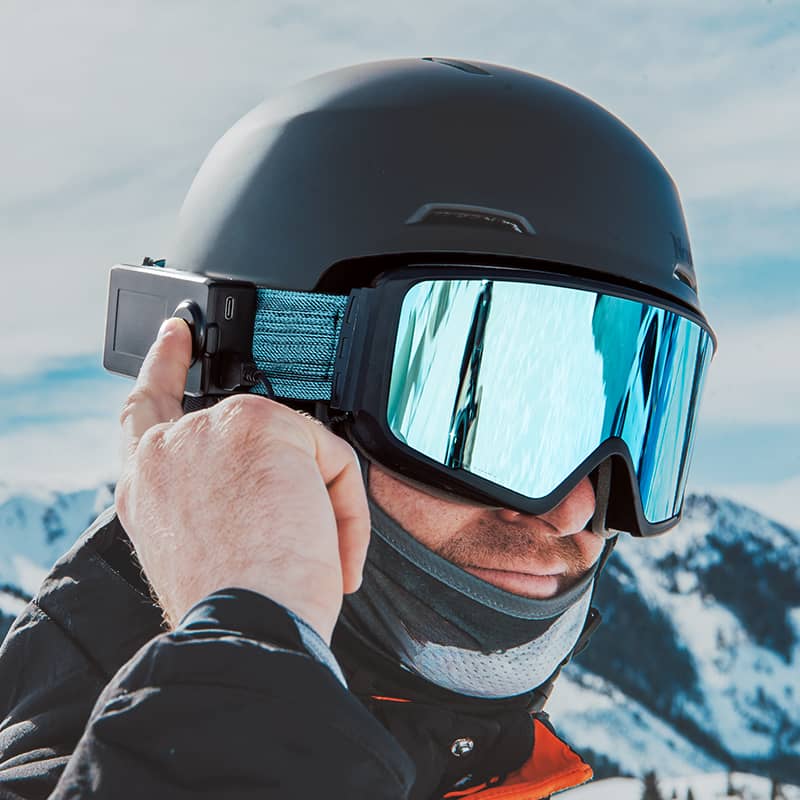
25年-香港展邀请函(横屏-英文版)-1024x358.jpg)

